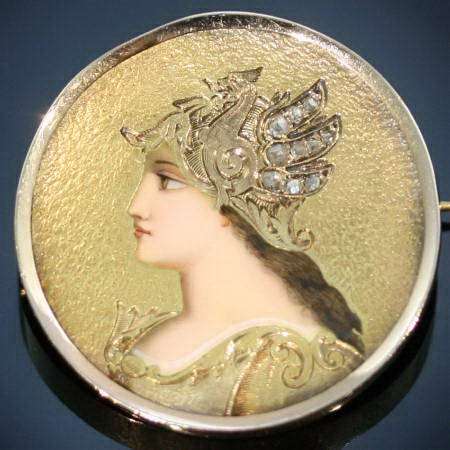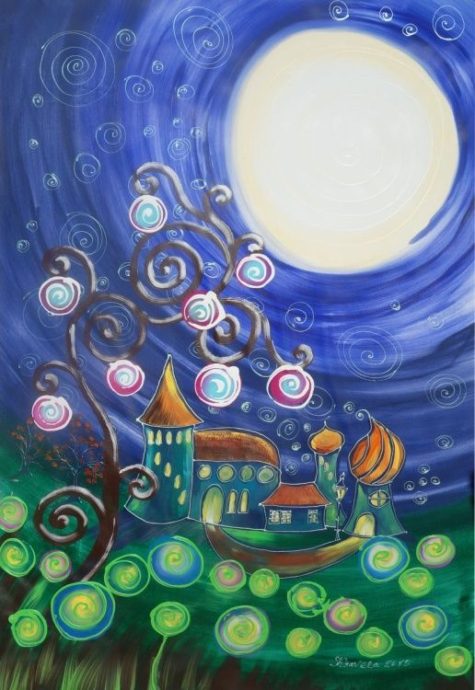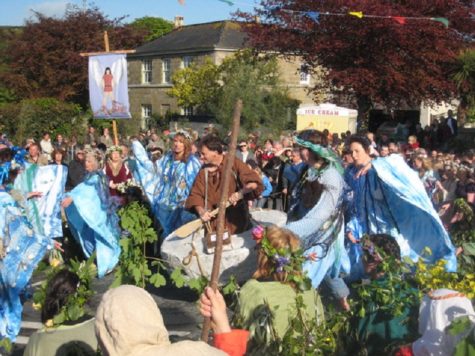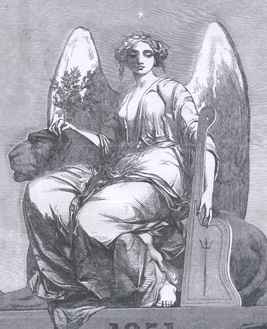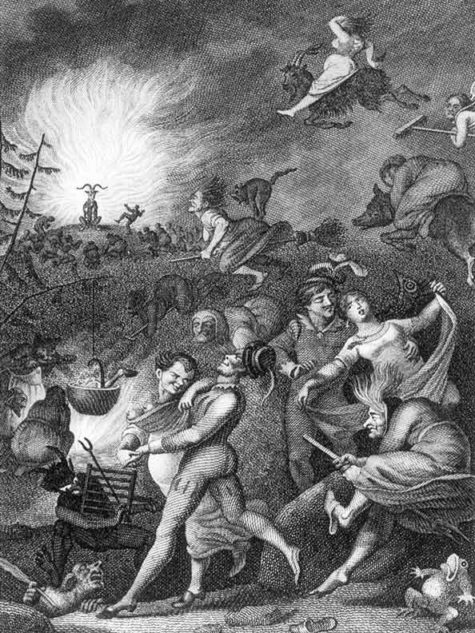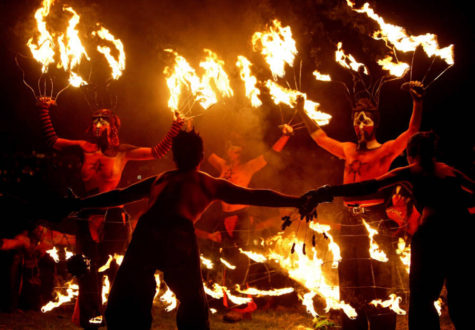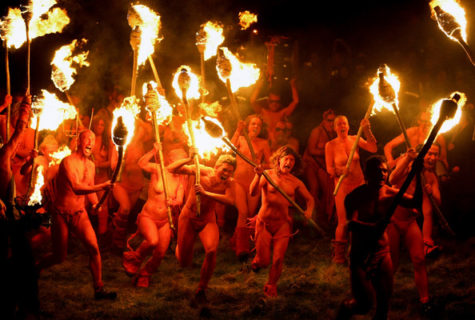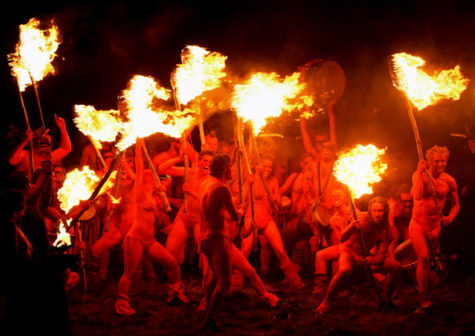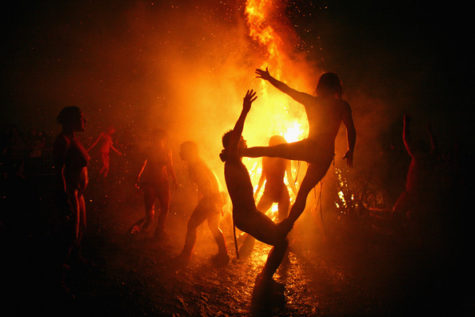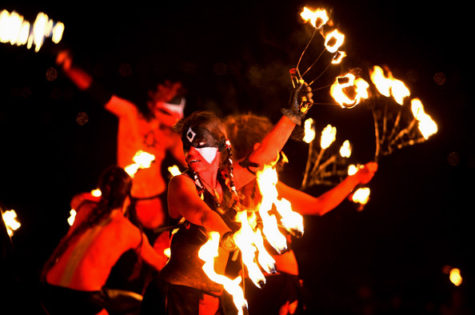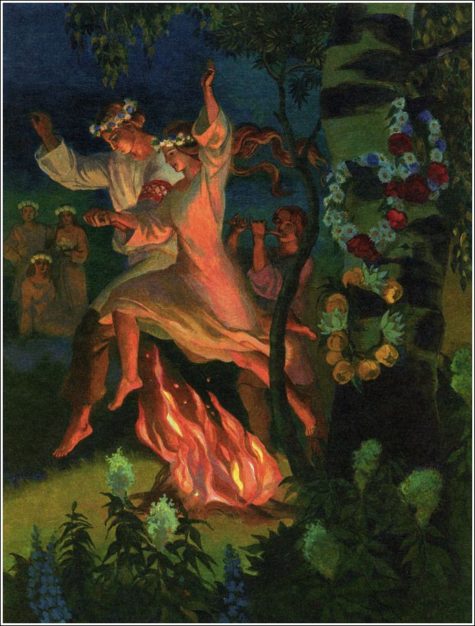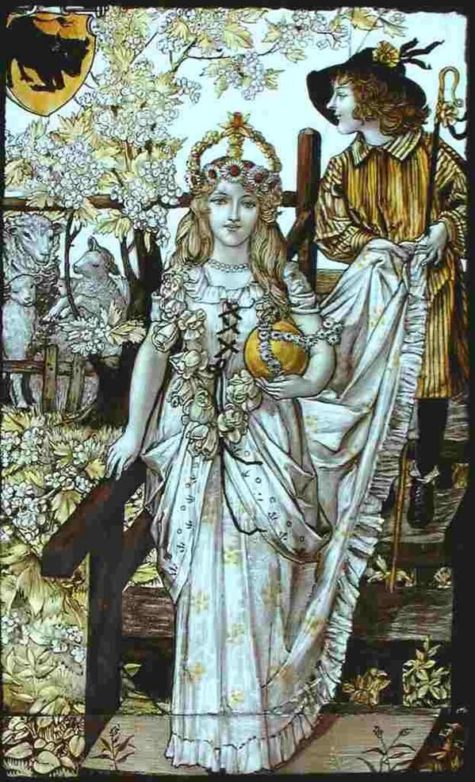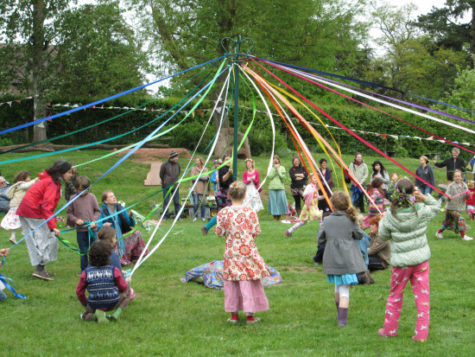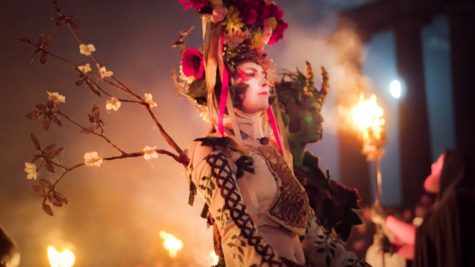May
The May full moon is also known as the Flower Moon, Milk Moon, Corn Planting Moon, and Corn Moon. The energies around this moon are ones of health, romance, love and wisdom. We are encouraged to begin to take action on the things we’ve recently been planning.
Once April’s rains and winds have subsided, the sun begins to warm up the earth and we’re able to get the gardens planted. Thus May is the month we begin to sow our crops. Get out in the garden under a Flower Moon and put your hands into the soil. May’s Moon brings us energy of love, wisdom and health. Spring is a time of fertility, and May is a fiery month indeed — full of lust and passion! It’s called the month of the Hare’s Moon — and we all know what hares are busy doing in the spring.
Correspondences:
- Colors: Red, orange, yellow
- Gemstones: Ruby, garnet, amber, Apache tear
- Trees: Hawthorn, rowan
- Gods: Kali, Priapus, Cernunnos, Flora
- Herbs: Cinnamon, members of the mint family
- Element: Fire
Gems and oils to boost the energy of the Hare’s Moon
- Gemstones: Malachite, Jade, Emerald, Peridot or any other green-hued stones.
These gems help enhance the energy of the heart chakra, which governs our compassion, generosity, love and harmony. If you need a boost in any of these areas, simply slip a green stone into your pocket, or put on a piece of green-gemmed jewelry.
- Essential Oils: Eucalyptus, Thyme, Sandalwood, Pine, Melissa, Bergamont.
These oils will help you connect with your unconscious mind and set the intention of love, wisdom and compassion
Celebrating The May Full Moon
The May full moon is a time when we begin to really notice more light in our lives. The days are longer, the grass is green and the flowers are starting to bloom. The energy at this time is playful and light, energetic and buoyant. If you want to really celebrate this moon and the energy it brings, you can do fun things like:
- host a pot-luck with a spring theme
- visit your local elementary school and volunteer during art class
- light a green candle and meditate on your thankfulness for the feeling of renewal and rejuvenation.
Other ideas:
Another great way to connect with the Hare’s Moon is to bless some seeds, seedlings or garden plants, and then plant them. Doing this involves intentionally adding positive energy to these plants, and then nurturing their growth and health. This is a powerful symbolic exercise that will help you focus your energy on intentionally giving “good vibes” to your environment. Doing this will make you feel empowered, positive and loving.
This is also a good time to work on magic related to careers and jobs. Thinking about switching to a new position, or perhaps trying a new field altogether? Want to take a class or get your degree? Take the seeds you’ve planted last month, and allow them to bloom and grow in your favor. Do some fire divination this month to help guide you on your way.
source: PaganWiccan
The Lemuria, the festival in honor of the Lemures, the spirits of dead family members who wander the earth on these three spring nights (May 9, 11, and 13).
The Lemuria is held on odd-numbered days because even-numbered days are considered unlucky. It is a festival designed to honor the Lemures, they are regarded as baleful spirits of the dead who died violent or otherwise untimely deaths.

At midnight, the Paterfamilias (head of the household) arises and dresses with no knots, buckles, or other constricting items on his person (thus he is barefoot). He makes the sign of the mano fico with his hands (a fist with the thumb placed between the index and middle fingers; a sign of good luck and fertility) and then washes his hands in pure water. He then walks through the house, spitting out nine black beans, being careful not to look behind him as the lemures accept the beans as a sort of ransom for the living members of the household. As he spits out each one, he says
“With these beans I redeem me and mine.”
Once all nine beans have been accepted by the lemures and the entire house walked through, the Paterfamilias then washes his hands again, clashes two vessels of bronze together, and nine times says
“Ghosts of my fathers, be gone.”
(Manes exite paternae.)
Source: Novaroma
According to many pagan calendars, May 8th is listed as “The Festival of Mens , the Roman goddess of mind and consciousness.” I did not, however, find any information on Mens or on a festival of Mens – what I did find was this small excerpt at Wikipedia:
By a process of folk etymology, the Romans could have confused the phones of her foreign name with those of the root men- in Latin words such as mens meaning “mind”, perhaps because one of her aspects as goddess pertained to the intellectual. The word mens is built from the Proto-Indo-European root *men- ‘mind’ (linked with memory as in Greek Mnemosyne; memory, remembrance, recollection, Manush in Sanskrit meaning mind ).
Because of this, I can only assume that the Festival of Mens is actually a Festival of Minerva, Goddess of wisdom and learning, meditation, inventiveness, accomplishments, the arts, spinning and weaving, and commerce. Minerva was identified with Pallas Athene, bestower of victory, when Pompey the Great built her temple with the proceeds from his eastern campaigns.
The Romans celebrated her festival from March 19 to March 23 during the day which is called, in the neuter plural, Quinquatria, the fifth after the Ides of March, the nineteenth, an artisans’ holiday. A lesser version, the Minusculae Quinquatria, was held on the Ides of June, June 13, by the flute-players, who were particularly useful to religion.
Source: Wikipedia
For the purpose of your magical escapades, the theme is definitely blossoming and liveliness. Use as many flower parts as possible in spells and rituals, and go outside frequently to get closer to nature. Energies emphasized by this month include creativity, inventiveness, fertility, health, and metaphysically “spring cleaning” any area of your life or sacred space.
Bring me my drum and bring me my cymbal,
Bring forth the sustrum, bring forth the timbal.
Dance now for Hathor, celebrate beauty,
dance in Her honor, sing for our lady.
May gets its name from the Roman goddess Maia, who embodies the earth’s renewal during spring. Next to New Year’s Eve, May Day was among the most popular holidays in the old world, marking the time when the sun’s warmth and nature’s fertility began appearing in the land. Later, well over one hundred nations chose to celebrate Labor Day on May 1, giving everyone a much-needed rest from winter’s tasks.
The Greek goddess Maia, the most important of the Seven Sisters (the Pleiades) and said to be the mother of Hermes, gave the name to this month. Some form of this goddess’s name was known to people from Ireland to as far away as India. The Romans called her Maius, goddess of Summer and honored her at the Ambarvalia, a family festival for purification and protection of farm land.
In the Celtic cultures, May was called Mai or Maj, a month of sexual freedom. Green was worn during this month to honor the Earth Mother. May 1 was the Celtic festival of Beltane, a festival celebrating fertility of all things. Cattle were drivien through the Beltane bonfires for purification and fertility. In Wales, Creiddylad was connected with this festival and often called the May Queen. The maypole and its dance is a remnant of these old festivities.
The Sheila Na Gig is still seen carved in the decorations of many Irish churches. This goddess figure is a grotesque, often emaciated, woman shown squatting and holding wide her private parts. Many Irish still know her as the protector of the poor and hang old clothes on hawthorn bushes on May 4th. This is believed to avert poverty. It is possible that the Australian term “Sheila,” used as a name for any woman, refers to this ancient deity and her carvings.
Bona Dea, the Roman Good Goddess, had her festival on the night between may 2nd and 3rd. No men were allowed to attend.
The Roman festival of Lemuria was to placate and remember the Lemures, or the wandering spirits of the dead. Each family performed its own private ceremonies, which ended with taking gifts to the graves. For those who had died and had no graves, the head of the household walked barefoot through the house, casting nine black beans behind him.
The Greeks had a special festival for the god Pan during May. Pan was a wild looking deity, half man, half goat. As a token of his frequent sexual adventures, he was shown with an erect penis. Pan invented the syrinx, or pan-pipes, made out of reeds. Originally, he was not an oppressor of women, but their loving companion.
May 19-28 was the solemn Greek festival called Kallyntaria and Plynteria. This was devoted to the cleaning and freshening of sacred statures and temples. The statues, small enough to be moved, were taken to a nearby river or lake and washed until clean. This was serious business with no singing or merry-making.
At the end of the month was a Roman celebration honoring the Underworld Queen Prosperina and her consort Pluto. Proserpina ruled over the resting place of the shades (souls), but her kingdom was connected with more than death. Pluto was also known as the deity of hidden wealth.
In Finland, May 1 was celebrated as Rowan Witch Day, a time of honoring the goddess Rauni, who was associated with the mountain ash or rowan. Twigs and branches of the rowan were, and still are, used as protection against evil in this part of the world. Some sources list Rauni as a god.
The Slavonic-Russian cultures had a similar, but longer, festival celebrating merriment, rivers, and well-being. This occured between May 25 and June 25. Originally it honored the goddess Lada, who later was changed to the god Lado.
Mugwort was a sacred herb in China and Europe. As part of the celebration on May 5, the Chinese made dolls out of the leaves. They hung these dolls above gates and doors to repel negative influences and entities.
In Tibet, an old Nature festival for the beginning of Summer and the rain deities became a celebration of Buddha’s death and his attainment of Buddha-hood. The attainment festival occurred on May 8, while celebration of Buddha’s death was on May 15. Deceased relatives were prayed for at this time.
The Incas held Aymoray Quilla or Hatun Cazqui, which was the Great Cultivation.
From: Moon Magick
What follows is a list (in alphabetical order) of the names given to the May moon. Also listed is the tradition and/or origin of that moon name:
Alewive Moon ~Passamaquoddy
Big Leaf Moon ~Mohawk
Blossom Moon ~Anishnaabe
Bright Moon ~Celtic
Corn Planting Moon ~Taos, Algonquin
Corn Weed Moon ~Agonquin
Dyad Moon ~other
Fat Horses Moon ~Cheyenne
Field Maker Moon ~Abernaki
Flower Moon ~other
Frog Moon ~Cree
Frogs Return Moon ~other
Grass Moon ~Neo Pagan
Green Leaf Moon ~Apache
Green Leaves Moon ~Dakota
Hare Moon ~Medieval English
Hoeing Corn Moon ~Winnebago
Idle Moon ~Assiniboine
Joy Moon ~other
Leaf Tender Moon ~San Juan
Little Corn Moon ~Natchez
Merry Moon ~other
Milk Moon ~Colonial American, Algonquin
Mothers Moon ~Janic (full)
Mulberry Moon ~Greek
Ninth Moon ~Wishram, Janic (dark)
Panther Moon ~Choctaw
Planting Moon ~Cherokee
Ponies Shed Moon ~Sioux
Shaggy Hair Moon ~Arapaho
Sproutkale Moon ~other
Strawberry Moon ~Potawatomi
Waiting Moon ~Hopi
The Furry Dance, also known as The Flora (or incorrectly as the Floral Dance), takes place in Helston, Cornwall, and is one of the oldest British customs still practiced today. The Dance takes place every year on May 8 (or the Saturday before if May 8 falls on a Sunday or Monday), and is a celebration of the passing of Winter and the arrival of Spring.
The dance is very well attended every year. Winter’s gone, so everybody’s out in the streets to celebrate the new life springing up all around. It seems like the whole of Cornwall is lining the streets, all freshly decorated with colourful flowers
The four dances and a Hal-an-Tow (a mystery play), spread across the day, starting with the first dance at 7.00 am, continuing with the children’s dance at 10.00 am, then the midday dance and culminating in the evening dance at 5.00 pm. Of these, the midday dance is perhaps the best known: it was traditionally the dance of the gentry in the town, and today the men wear top hats and tails while the women dance in their finest frocks.
The Dance twists and turns its way through this ancient Cornish town and the route doesn’t change, even if that means that the Flora Dance has to traipse through people’s houses, across their gardens or straight through the shops.
The whole town is decorated with greenery, many of the people are wearing greenery outfits and the Town Band play all day long, providing music to the dancers, they have a splash of greenery in their hats too, you’ll notice this is Lily of the Valley, which is Helston’s symbolic flower. The gentlemen wear it on the left, with the flowers pointing upwards, and the ladies wear it upside down on the right.
Originally, most likely, a May Day celebration, it was moved to May 8th to commemorate the town’s patron saint, St Michael, who is said to have saved the town from what appears to be a meteorite hit in AD 495, you can still see the boulder that crashed down as it’s still visible as a wall in the Angel Yard.
Source: Cornish Festivals
Have Your Own Furry Dance:
The Furry Dance is an ancient festival that rejoices in spring’s warmth and beauty. To bring this energy into your life, it’s customary to dance with a partner. In fact, the more people you can get dancing, the more fortunate the energy! Usually this is done on the streets throughout a town as a show of regional unity, but when propriety won’t allow such a display, just dance around a room together instead. Don’t worry about the steps – just do what feels right.
- Themes: Unity; Joy; Luck
- Symbols: Flowers; Triangle
- Presiding Goddess: Tanat
In Cornwall, Tanat is the mother goddess of fertility who has given all her attention to nursing spring into its fullness. She also staunchly protects her children (nature and people) so that our spirits can come to know similar fulfillment.
Wearing something with floral or triangular motifs (guys, wear a necktie, and gals, pull out a square scarf and fold it crosswise) activates Tanat’s happiness in your life and in any region where you have the token on today. As you don the item, say:
Liberate happiness in and around,
by Tanat’s blossoming power, joy will be found!
Or if you want to use the same thing to generate unity and harmony, use this incantation:
Harmony and unity,
Tanat’s blessings come to me.
From: 365 Goddess
The Bona Dea had a festival on the first of May that commemorated the date her Aventine temple was founded. Its date connects her to Maia; its location connects her to Rome’s plebeian commoner class. At the ceremony, prayers were made to Her to avert earthquakes. She also had a secret festival, attended only by women, that took place over the night of the 3rd and 4th of May.
The rites are inferred as some form of mystery, concealed from the public gaze and, according to most later Roman literary sources, entirely forbidden to men.
On this night the festival was held in the house of the consul (the chief elected official), and no men were allowed. This taboo extended even to paintings or statues of men, which were required to be covered during the rites—and one assumes the consul himself crashed at a friend’s place for the night. The Vestal Virgins officiated, led by the wife of the consul (probably symbolic of the ancient Queen, on whom fell certain sacred religious duties), and the house was decorated like a temple with garlands of leaves and flowers of all kinds, except for myrtle of course, and the women wore wreaths of grape leaves.
A great jar of wine was placed in the room, though it must be referred to as “milk”, and the jar itself was called a mellarium, or “honey jar.” After making libations to the Goddess, music was played and the women drank and danced.
In the Republican era, Bona Dea’s Aventine festivals were probably distinctly plebeian affairs, open to all classes of women and perhaps, in some limited fashion, to men. By the Late Republic era, Bona Dea’s May festival and Aventine temple could have fallen into official disuse, or official disrepute.
The goddess also had a Winter festival (see it here), it was held in December during the Faunalia, and was referred to as the sacra opertum, (“the secret or hidden sacrifice”): at this ritual sacrifices were made for the benefit of all the people of Rome, something proper to the realm of a mother or Earth Goddess who is concerned with the well-being of all of Her children.
Ritual for Bona Dea:
- Color: Green
- Element: Earth
- Offerings: Leave a pig-shaped cookie out for the wild things.
- Daily Meal: Soups or stews, preferably with herbs. Herbal tea.
Altar:
Upon a green cloth set five candles in different colors, a chalice of milk mixed with honey, incense of sandalwood and myrrh, the figure of a snake, a plate of cookies shaped like pigs, a pot of medicinal herbal tea, cups, and pots of dried herbs gathered throughout the year.
Invocation to Bona Dea
O Bona Dea,
Good Goddess of the Earth
Whose name is mystery,
Whose name is a hundred names,
Whose spirit lives in us all
And in every goddess who touches the soil,
And in every mortal who sprang from the clay,
Be with us on this day!
You have made the Earth spring forth
With many green goods for us,
Not merely those with which me feed our bellies,
But also those which heal our bodies.
Lady who heals us, godmother of Hygeia,
Daughter of Faunus who tracks in the wild,
We find your gifts both in our gardens
And on the wild paths where you have trodden.
We see the healing herbs springing up
In each of your passing footprints,
And we are grateful for our lives.
O Bona Dea,
Good Goddess of the Earth
Whose name is mystery
But whose gifts are so concrete,
We revere you and ask that you bless this day
Your plants which you have so generously given us,
That we may always be healed
And always help to heal others.
The names of the herbs that were collected and placed on the altar are called out one by one, in this manner:
“For the power of Rosemary, we are grateful!”
All reply in turn, “We are grateful!”
Pass the tea and cookies and eat them.
Sources: Pagan Book of Hours and Wikipedia
In Germany, Walpurgisnacht (or Hexennacht, meaning witches´ night), the night from April 30 (May eve), is the night when allegedly the witches hold a large celebration on the Blocksberg (the highest of the Harz Mountains of north central Germany) hold revels with their Gods, and await the arrival of Spring.
In some parts of northern coastal regions of Germany, the custom of lighting huge Beltane fires is still kept alive, to celebrate the coming of May, while most parts of Germany have a derived christianized custom around Easter called “Easter fires”.
In rural parts of southern Germany it is part of popular youth culture to go out on Walburgisnacht to play pranks on other people, like messing up someone’s garden, hiding stuff or spraying messages on other people’s property. Sometimes these pranks go too far and may result in serious willful damage to property or bodily injury.
Walpurgis (sw: Valborg) is one of the main holidays during the year in both Sweden and Finland, alongside Christmas and Midsummer. The forms of celebration in Sweden vary in different parts of the country and between different cities. One of the main traditions in Sweden is to light large bonfires, a custom which is most firmly established in Svealand, and which began in Uppland during the 18th century. An older tradition from Southern Sweden was for the younger people to collect greenery and branches from the woods at twilight, which were used to adorn the houses of the village. The expected reward for this task is to be paid in eggs.
Today in Finland, Walpurgis Night (Vapunaatto) is, along with New Year’s Eve, the biggest carnival-style festivity that takes place in the streets of Finland’s towns and cities. The celebration is typically centered on plentiful use of sparkling wine and other alcoholic beverages. The student traditions are also one of the main characteristics of “Vappu“. From the end of the 19th century, “Fin de Siècle“, and onwards, this traditional upper class feast has been co-opted by students attending university, already having received their student cap. Many people who have graduated from lukio wear the cap.
One tradition is drinking sima, whose alcohol content varies. Fixtures include the capping of the Havis Amanda, a nude female statue in Helsinki, and the biannually alternating publications of ribald matter called Äpy and Julkku. Both are sophomoric; but while Julkku is a standard magazine, Äpy is always a gimmick. Classic forms have included an Äpy printed on toilet paper and a bedsheet. Often the magazine has been stuffed inside standard industrial packages such as sardine-cans and milk cartons. The festivities also include a picnic on May 1st, which is sometimes prepared in a lavish manner.
The Finnish tradition is also a shadowing of the Soviet Era May Day parade. Starting with the parties of the left, the whole of the Finnish political scene has nominated Vappu as the day to go out on stumps and agitate. This does not only include right-wing parties, but also others like the church have followed suit, marching and making speeches.
In Sweden it is only the labor and socialist parties which use May 1 for political activities, while others observe the traditional festivities. The laborers who were active in the 1970’s still party on the first of May. They arrange carnivals and the radio plays their old songs that workers liked to listen to. The labor spirit lies most in the capital of Finland, Helsinki.
The First of May is also a day for everything fun and crazy: children and families gather in market places to celebrate the first day of the spring and the coming summer. There are balloons and joy, people drink their first beers outside, there are clowns and masks and a lot of fun. The first of May includes colorful streamers, funny and silly things and sun. The first of May means the beginning of the spring for many people in Finland.
Traditionally May 1st is celebrated by a picnic in a park (Kaivopuisto in the case of Helsinki). For most, the picnic is enjoyed with friends on a blanket with good food and sparkling wine. Some people, however, arrange extremely lavish picnics with pavilions, white table cloths, silver candelabras, classical music and lavish food. The picnic usually starts early in the morning, and some hard-core party goers continue the celebrations of the previous evening without sleeping in between. Some Student organisations have traditional areas where they camp every year and they usually send someone to reserve the spot early on. As with other Vappu traditions, the picnic includes student caps, sima, streamers and balloons
The tradition which is most widespread throughout the country is probably singing songs of spring. Most of the songs are from the 19th century and were spread by students’ spring festivities. The strongest and most traditional spring festivities are also found in the old university cities, like Uppsala and Lund where both current and graduated students gather at events that take up most of the day from early morning to late night on April 30, or “sista April” (“The last day of April”) as many people call it. There are also newer student traditions like the carnival parade, The Cortège, which has been held since 1909 by the students at Chalmers in Gothenburg. In Sweden, Valborg is especially notorious because of the excessive amounts of alcohol people consume on that day.
Found at: Nation Master
Here’s how they celebrate Beltane in Edinburgh!
Enjoy!
First organized in the 1980’s, the Beltane Fire Festival has become a popular festival in Edinburgh. Here we have photos of the Beltane Fire Society celebrating Spring and the coming of summer. This lively procession celebrates the ending of winter and is a revival of the ancient Celtic festival of Beltane which is the Gaelic name for the month of May. More about Beltane can be found here: Beltane
The first of May is Beltane or May Day, a time to celebrate the leaping fires of passion. Traditionally celebrated on April 30, (May eve), it marks the height of spring and the flowering of all life. Beltane is a festival of sensuality, sexuality, flowers and delight. It is a traditional time to make love, preferably outdoors.
Beltane is the time when fairies return from their winter rest, carefree and full of mischief and delight. On the night before Beltane, in times past, folks would place rowan branches at their windows and doors for protection. If you do not wish the fairies to visit, do the same! This is also a perfect time for night or predawn rituals to draw down power to promote fertility in body and mind.
At Beltane, the Pleiades star cluster rises just before sunrise on the morning horizon. The Pleiades is known as the seven sisters, and resembles a tiny dipper-shaped pattern of six moderately bright stars in the constellation of Taurus, near the shoulder. Watch for it low in the east-northeast sky, just a few minutes before sunrise.
There are many lovely old customs associated with this time. Here are some simple ideas for celebrating this wild red time of year:
- Make a garland or wreath of freshly picked flowers and wear it in your hair.
- Dress in bright colors, especially hot pink or crimson, the traditional colors of Beltane, or wear green all day (and nothing all night!)
- Hang fruits and baked goodies from trees and bushes for later feasting.
- Build a Beltane fire: leap over it to cleanse yourself, or state your desires and let the fire carry them upward.
- Leap over your garden rows (or house plants), sharing joyous energy.
- Make a ‘May gad’: peel a willow-wand and twine cowslips or other flowers around it.
- Throw a May Day party and feast on May wine and food till the dawn. Turn a broomstick into a maypole and see how many people you can get to dance round it.
- Make love in the woods, in your garden, outside – at night.
- Watch the sunrise. Pack a picnic breakfast, a blanket, and some sweaters; and head out before dawn. Unpack your picnic on a hill with an unobstructed view and enjoy the early morning rays as the sun peaks over the horizon.
- Make a flower feast! Freeze edible flowers in your ice cubes. Add edible flowers to your salad. Candy flowers to decorate your dessert.
- Make a May basket. Fill it with flowers, food, ribbons, and fun. Leave it on a doorstep of a lover or friend, or someone who cannot get outside, such as an invalid or elderly person.
- Make a daisy chain and cast it into one of the lakes to please the water spirits.
- Rise at dawn on May Day and wash in the morning dew: The woman who washes her face in it will be beautiful, the man who washes his hands will be skilled at knots and nets (always a useful skill for students).
- Twist a Rowan sprig into a ring and look through it- tonight is one of the three in the year when the uninitiated can see the faeries.
- Create a May Day altar with a mirror, a small maypole, a phallic shaped candle, a daisy chain and springtime flowers.
- Light a fire or candle on the top of a hill and make a wish as you jump over it (for authenticity, you can try this sky clad, it would also be amusing for any passing late-night dog walkers!)
- Perfume your house with delicate scent of woodruff, a tiny, star-like flower that blooms around this time in the Northern Hemisphere.
- Embrace the ones you love. Hugs and kisses all around.
Holidays are days made holy by the attention we pay them. Simple practices such as the ones listed above remind us that we too dance to the natural rhythms of the earth.
Honor The May Queen
Make an offering of a floral crown, or a libation of honey and milk, to the Queen of the May during your Beltane prayers.
The leaves are budding across the land
on the ash and oak and hawthorn trees.
Magic rises around us in the forest
and the hedges are filled with laughter and love.
Dear lady, we offer you a gift,
a gathering of flowers picked by our hands,
woven into the circle of endless life.
The bright colors of nature herself
blend together to honor you,
Queen of spring,
as we give you honor this day.
Spring is here and the land is fertile,
ready to offer up gifts in your name.
we pay you tribute, our lady,
daughter of the Fae,
and ask your blessing this Beltane.
Make A Maypole for Beltane
This isn’t as difficult as you might think. Purchase a twenty foot wood pole from your local hardware store, or make a shorter one with a yardstick, broomstick, or even a twig. Set it up in your backyard.
Invite a group of friends, and ask each one to bring a 2 inch by 20 foot length of brightly colored ribbon (or whatever the length of your pole). Alternatively, you could provide ribbons of various colors. At the top of the pole affix the different colored ribbons – one for each person.
When your guests have assembled, have them each choose a ribbon and make a wish upon it.(For example, “I choose this red ribbon for more passion in my life.”) Everyone grabs their ribbon, and the dancing begins. (Make sure to have extra ribbons just in case!) Dance around the Maypole entwining your ribbons together. And then feast on May wine and food till the dawn.
More About Beltane
For the Celts, Beltane marked the beginning of the pastoral summer season when the herds of livestock were driven out to the summer pastures and mountain grazing lands. In modern Irish, Mí na Bealtaine (‘month of Bealtaine’) is the name for the month of May. The name of the month is often abbreviated to Bealtaine, with the festival day itself being known as Lá Bealtaine. The lighting of bonfires on Oidhche Bhealtaine (‘the eve of Bealtaine’) on mountains and hills of ritual and political significance was one of the main activities of the festival.
Beltane is a cross-quarter day, marking the midpoint in the Sun’s progress between the vernal equinox and summer solstice. Since the Celtic year was based on both lunar and solar cycles, it is possible that the holiday was celebrated on the full moon nearest the midpoint between the vernal equinox and the summer solstice. The astronomical date for this midpoint is closer to May 5 or May 7, but this can vary from year to year.
In Irish mythology, the beginning of the summer season for the Tuatha Dé Danann and the Milesians started at Bealtaine. Great bonfires would mark a time of purification and transition, heralding in the season in the hope of a good harvest later in the year, and were accompanied with ritual acts to protect the people from any harm by Otherworldly spirits, such as the Sídhe.
Like the festival of Samhain, opposite Beltane on Oct. 31, Beltane was a time when the Otherworld was seen as particularly close at hand. Early Gaelic sources from around the 10th century state that the druids of the community would create a need-fire on top of a hill on this day and drive the village’s cattle through the fires to purify them and bring luck (Eadar dà theine Bhealltainn in Scottish Gaelic, ‘Between two fires of Beltane’).
In Scotland, boughs of juniper were sometimes thrown on the fires to add an additional element of purification and blessing to the smoke. People would also pass between the two fires to purify themselves. This was echoed throughout history after Christianization, with lay people instead of Druid priests creating the need-fire.
The festival persisted widely up until the 1950s, and in some places the celebration of Beltane continues today. A revived Beltane Fire Festival has been held every year since 1988 during the night of 30 April on Calton Hill in Edinburgh, Scotland and attended by up to 15,000 people (except in 2003 when local council restrictions forced the organizers to hold a private event elsewhere).
Wiccans and Wiccan-inspired Neopagans celebrate a variation of Beltane as a sabbat, one of the eight solar holidays. Although the holiday may use features of the Gaelic Bealtaine, such as the bonfire, it bears more relation to the Germanic May Day festival, both in its significance (focusing on fertility) and its rituals (such as maypole dancing). Some Wiccans celebrate ‘High Beltaine’ by enacting a ritual union of the May Lord and Lady.
~Information from various sources including Paganwiccan

